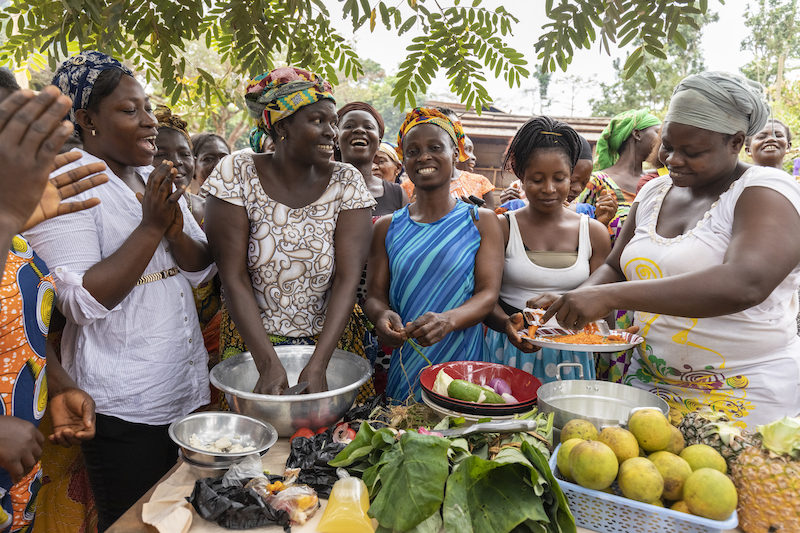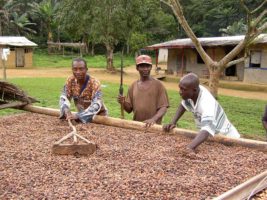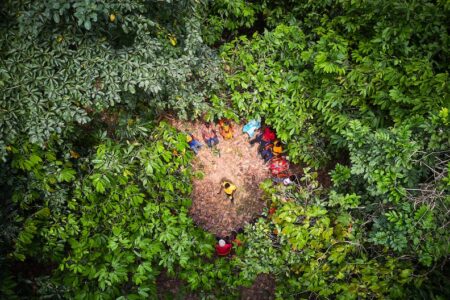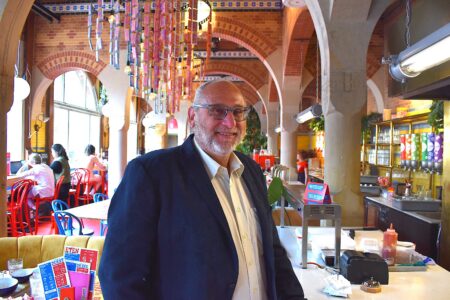Cargill’s planet action plan drives progress on CFI cocoa initiative

Cocoa growing community in Ghana, pic (Cargill)
Cargill has issued an update on its Protect Our Planet Strategic Action Plan, which has for the past four years explored how the company can improve its cocoa supply chain, reports Neill Barston.
As the company explained, the scheme is directly linked to its involvement with the Cocoa & Forest Initiative (CFI) venture between governments and key industry partners, including major corporations including Mars, Mondelez and Ferrero, tackling deforestation.
In addition to being a signatory to that initiative, the company said that its strategic plans had made notable gains deploying technology to offer unprecedented visibility into the supply chain, helping it map farms, trace cocoa, assess deforestation risk and engage suppliers.
This is being undertaken in its operations within Ghana, Ivory Coast and three other countries that it sources from. It is also engaged with other third party suppliers in a bid to further tackle the risks of deforestation with its supply chains.
Deforestation, alongside the ongoing issue of child labour within West Africa – where more than 1.5 million minor remain exposed to labour risks, remains at the core of the industry’s sustainability focus, and Cargill has engaged notably on monitoring systems for tackling illegal labour practices, though as previously acknowledged to Confectionery Production, it remains a notable ongoing mission.
Significantly, the company said it had used GPS to map the polygon farm boundaries of 64% of all farmers participating in the Cargill Cocoa Promise programme. These polygon mapping techniques are considered important because of its precise ability to map and monitor the individual sources of cocoa, which are frequently very small farms.
“Thanks to our investments in technology and partnerships, we are able to see the sources of our cocoa like never before, and that clarity will continue growing sharper,” said Sebastiaan van der Hoek, climate and land use advisor for Cargill’s cocoa and chocolate business. “This monitoring benefits farmers, too, as it helps provide greater assurance to the market, consumers and regulators that they are growing cocoa in a responsible and sustainable way.”
Furthermore, the company added that it is also working with the World Cocoa Foundation, Climate Focus and World Resources Institute, as well as other cocoa companies, to develop a comprehensive dataset of cocoa plot locations in the direct supply chain and an aligned method for assessing deforestation risk to help realise effective landscape partnerships and contribute to deforestation monitoring.
As part of this strategy, an aggregate view of cocoa plot locations across West Africa will provide a basis for identifying opportunities for pre-competitive collaboration. The company added that paired with the outputs of the risk assessment, collaboration can proceed in the areas that matter most for addressing deforestation.
The creation of the comprehensive dataset is underway, and a beta version of the risk assessment has been developed. The final risk assessment will go through a peer review process and be made available as a freely accessible public good through WRI’s Global Forest Watch platforms to help drive aligned deforestation risk management across the cocoa sector for impact at scale.
Government agreement
In addition, last month the firm signed a memorandum of understanding (MOU) with Côte d’Ivoire’s Ministry of Water and Forests to help protect and restore the Dassioko classified forest, which holds some of the last remaining tracts of high-conservation-value coastal rainforests in the country. The MOU includes helping communities near the forest create development plans that safeguard forest resources while also contributing to farmer livelihoods and overall community well-being.
The company also cited its progress on developing agroforestry solutions in relation to its cocoa operations, which it said can can help protect native forests while also providing additional income-generating opportunities for farmers.
“Agroforestry holds a great deal of promise to helping solve a challenging equation: protecting the planet and strengthening communities at the same time,” Sebastiaan said.
As part of this, in 2020-21, the business promoted cocoa agroforestry practices to more than 14,700 farmers across Ghana and Côte d’Ivoire and distributed more than 1.1 million multi-purpose trees for on-farm planting. Since 2018, we have supported more than 30,000 farmers in adopting agroforestry and distributed nearly 2 million trees. This led to expanding projects such as its PUR Projet, IMPACTUM, FOA S.A.R.L. and Agromap, that will continue to support on-farm restoration and forest protection in the buffer zones of important conservation areas.

“It is time to protect trees as our children,” said PUR Projet’s Diomandé Moussa, who works with farmers in Ivory Coast. He went on to explain that everyone – farmers, cooperatives, NGOs and companies – have a role to play.
Climate work
Another area where Cargill Cocoa & Chocolate is making steady progress is in measuring carbon emissions associated with our cocoa and chocolate products – and helping customers understand and address their carbon footprints. We recently conducted a thorough analysis based on established benchmarks that was verified by sustainability consulting firm Quantis.
We know that nearly all the emissions from Cargill’s cocoa and chocolate business come from Scope 3 – our supply chain. And the majority of those are due to land use changes, usually deforestation. It’s why we are taking actions through the key partnerships described above.
We have a very accurate view of our Scope 3 emissions which enables us to address these with attention, track progress and help our customers understand their carbon footprints and offer solutions to help reduce them. Customers can get visibility into their carbon emissions data and related insights through our CocoaWise™ Portal.
“We want to be the foremost partner in our customers’ minds when it comes to understanding the impact of the cocoa they buy, reducing that impact, and telling the story to the consumers who enjoy their products,” Sebastiaan said.



